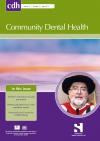Community Dental Health

- Cover Date:
- June 2015
- Print ISSN:
- 0265 539X
- Vol:
- 32
- Issue:
- 2
The association between parents’ perceived social norms for toothbrushing and the frequency with which they report brushing their child’s teeth
© BASCD 2015 doi:10.1922/CDH_3512Trubey06
The association between parents’ perceived social norms for toothbrushing and the frequency with which they report brushing their child’s teeth
R.J. Trubey, S.C. Moore and I.G. Chestnutt
Objectives: To determine whether parents’ judgements on how often other parents brush their children’s teeth are associated with the frequency with which they brush their own children’s teeth, and their satisfaction with their child’s brushing routine. Methods: A cross-sectional questionnaire survey completed by 297 parents of children aged 3-6. Parents were asked how often they brushed their own child’s teeth per week, how often they thought other parents did so, and how satisfied they were with their child’s toothbrushing routine. Demographic data were also collected. Results: The mean frequency that parents brushed their children’s teeth was 12.5 times per week. Multiple regression analysis tested the relationship between parents’ perceptions of other parents brushing frequency (mean 10.5 times per week) and how often they brushed their own child’s teeth, controlling for socio-demographic factors, and yielded a positive association (p<0.001). There was a positive association between parents’ satisfaction with their child’s brushing routine and the extent to which they thought it was better than that of the average child (p<0.001). Conclusions: Parents’ judgements on how frequently other parents brush their children’s teeth are associated with their own behaviour and satisfaction. Re-framing oral health messages to include some form of social normative information (“most parents do thisâ€) may prove more persuasive than simple prescriptive advice (“you should do thisâ€).
Key words: oral health, toothbrushing, oral health promotion, caries, children, social norms
- Article Price
- £15.00
- Institution Article Price
- £
- Page Start
- 98
- Page End
- 103
- Authors
- R.J. Trubey, S.C. Moore, I.G. Chestnutt
Articles from this issue
- Title
- Pg. Start
- Pg. End
- Dentists’ knowledge of oral health during pregnancy: a review of the last 10 years’ publications
- 77
- 82
- A pilot project to improve the oral health of orphans and of the elderly in residential care in Constanta, Romania
- 89
- 92
- The association between parents’ perceived social norms for toothbrushing and the frequency with which they report brushing their child’s teeth
- 98
- 103
- Are Stage of Change constructs relevant for subjective oral health in a vulnerable population?
- 111
- 116
